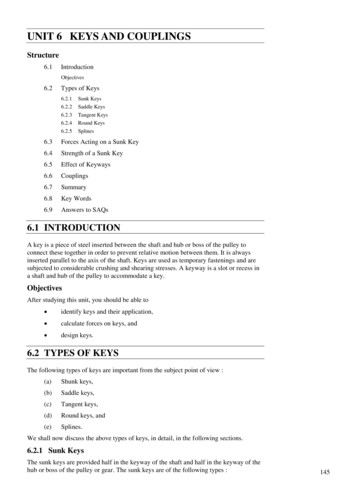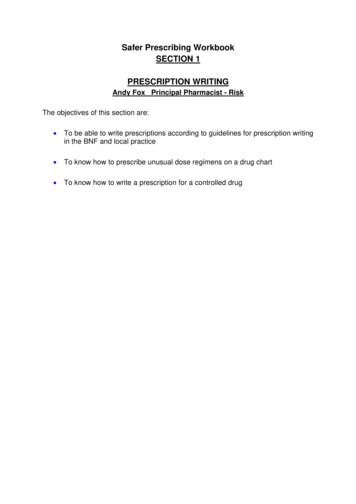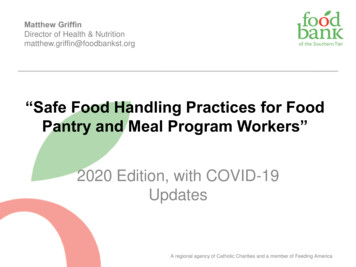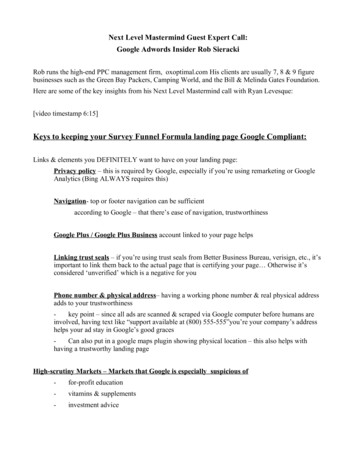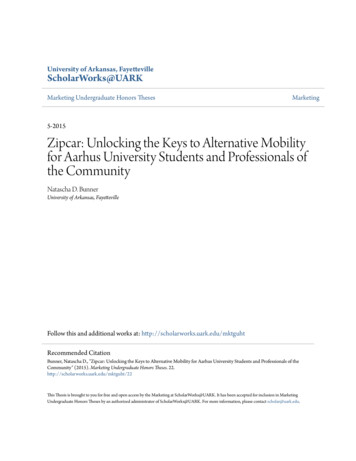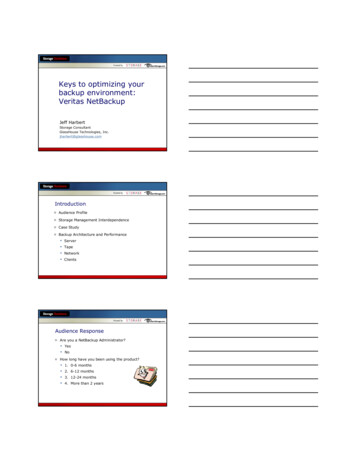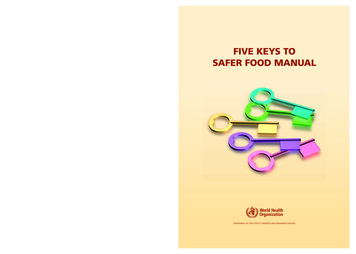
Transcription
FIVE KEYS TOSAFER FOOD MANUALDEPARTMENT OF FOOD SAFETY, ZOONOSES AND FOODBORNE DISEASES
FIVE KEYS TOSAFER FOOD MANUALDEPARTMENT OF FOOD SAFETY, ZOONOSES AND FOODBORNE DISEASES
INTRODUCTIONFood safety isa significant publichealth issueUnsafe food has been a human health problem since history was first recorded, and many food safetyproblems encountered today are not new. Although governments all over the world are doing their bestto improve the safety of the food supply, the occurrence of foodborne disease remains a significant healthissue in both developed and developing countries.It has been estimated that each year 1.8 million people die as a result of diarrhoeal diseases and most of thesecases can be attributed to contaminated food or water. Proper food preparation can prevent most foodbornediseases.More than 200 known diseases are transmitted through food.1The World Health Organization (WHO) has long been aware of the need to educate food handlers abouttheir responsibilities for food safety. In the early 1990s, WHO developed the Ten Golden Rules for Safe FoodPreparation, which were widely translated and reproduced. However, it became obvious that somethingsimpler and more generally applicable was needed. After nearly a year of consultation with food safetyexperts and risk communicators, WHO introduced the Five Keys to Safer Food poster in 2001. The Five Keysto Safer Food poster incorporates all the messages of the Ten Golden Rules for Safe Food Preparation undersimpler headings that are more easily remembered and also provides more details on the reasoning behind thesuggested measures.The Five Keys to Safer Food PosterThe core messages of the Five Keys to Safer Food are: (1) keep clean; (2) separate raw and cooked; (3) cookthoroughly; (4) keep food at safe temperatures; and (5) use safe water and raw materials. The poster has beentranslated into more than 40 languages and is being used to spread WHO’s food hygiene message throughoutthe world.14Mead, P.S., et al, Food-Related Illness and Death in the United States Emerging Infectious Diseases, Vol 5, No. 5, 1999.INTRODUCTION
The Five Keys to Safer Food ManualThe Five Keys to Safer Food Manual is divided into two sections. Section One is Background Material andSection Two is the Five Keys to Safer Food. Section Two elaborates the core food safety information provided inthe WHO Five Keys to Safer Food poster and suggests how to communicate these messages. When presentingthe material on the Five Keys to Safer Food it is important that this core information and rational (i.e. why)remain the same as that presented in the poster.The information in Section One: Background Material is not meant to be presented in its current format. Thetrainer has flexibility on how and when to discuss the points provided in this section. The trainer should identifypoints within this section that are applicable to the audience and integrate these points into the presentationof the material in section two.In both sections information is divided into two columns. The first column contains basic information thatshould be presented to all audiences. The second column contains additional information which is not designedto be presented to the audience, but is designed to aid the trainer in answering questions. For some sections,the manual also presents “Considerations and suggestions for the trainer”, i.e. ways to adapt the material fordifferent audiences and different locations.When adapting the manual to prepare a training session, the following points and questions should beconsidered.¡Who is the audience (e.g. school children, young adults, home food handlers, food workers)?¡Will the audience understand the level of language used?¡Have enough visual cues been incorporated to accommodate those who might not understandthe language?¡Is the material of an appropriate length to capture and hold the audience’s attention?¡Are instructions clear, concise and easy to follow?¡Is the material presented in an interesting way that is easy to remember and understand?¡Does the material reinforce the core information?¡Have examples of local foods been incorporated?¡Are local food practices discussed?¡Does the material reflect local facilities (i.e., running water, refrigerators, etc.)?Although the information provided in the FiveKeys to Safer Food Manual will be adaptedfor each audience, the concepts of the coreinformation should remain the same as thatin the WHO Five Keys to Safer Food poster.FIVE KEYS TO SAFER FOOD MANUAL5
EvaluationAll aspects of the Five Keys to Safer Food training material should be evaluated. Included in the manualare two evaluation forms: one for the organizer and/or trainer and one for the participant. The evaluationform for the organizer and/or trainer evaluates the demographics of the audience and the suitability of theadaptation process and whether or not the training session achieved its goal. The evaluation form for theparticipants evaluates the impact of the training session on food safety knowledge, attitude and behaviours.It is recommended that the participants complete one evaluation form before the training session and oneevaluation form after the training session.GlossaryA glossary of terms used in the manual is provided for reference.ResourcesThis section contains additional information for the organizer, trainer and participants. In addition to this manual,WHO intends to develop supplemental materials targeted to different audiences including school children andwomen as well as other supplemental materials on different food safety topics. When developed this informationwill be available at the web site: lWHO aims to improve the exchange and reapplication of practical food safety knowledge among MemberStates by having them exchange experiences and tested solutions. A section of the WHO Food Safety website was designed to enable countries and partners to access the different tools produced in different parts ofthe world. One can actively contribute to the success of delivering the Five Keys to Safer Food public healthmessage and prevent foodborne disease by exchanging ideas, materials and experiences on this web site.6INTRODUCTION
Sec tion One : Background MaterialWhat is the problem?Every day people all over the world get sick fromthe food they eat. This sickness is called foodbornedisease and is caused by dangerous microorganismsand/or toxic chemicals.Most foodborne disease is preventable with properfood handling.Additional informationFoodborne Disease: Is a problem in both developing and developedcountries; Is a strain on health care systems; Severely affects infants, young children, elderlyand the sick; Creates a vicious cycle of diarrhoea andmalnutrition; and Hurts the national economy and developmentand international trade.Considerations and suggestions for the trainerFor simpler language, use the terms “germ” for microorganisms and “poisons” for toxic chemicals.What are microorganisms?Additional informationMicroorganisms are very small living things, so smallthat they cannot be seen with the naked eye. Thereare three different types of microorganisms: the good,the bad and the dangerous.Microorganisms are so small that it takes1 million to cover the head of a pin.Good microorganisms are useful. They:The smell, taste and appearance of food are notgood indicators of whether the food will make yousick. Some spoilage microorganisms do change theappearance of food and are dangerous. An example isthe green mould on bread which can produce toxins. Make food and drinks (e.g. cheese, yoghurt, beerand wine); Make medicine (e.g. penicillin); and Help digest food in the gut.Bad microorganisms, or spoilage microorganisms, donot usually make people sick, but they cause our foodto smell bad, taste horrible and look disgusting.Dangerous microorganisms make people sick and caneven kill. These are called “pathogens”. Most of thesemicroorganisms do not change the appearance of thefood.Bacteria, viruses, yeasts, moulds and parasites areall microorganisms.Examples of common dangerous foodbornemicroorganisms include: Bacteria - Salmonella, Shigella, Campylobacterand E. coli; Parasites - Giardia, Trichinella; and Viruses – Hepatitis A, Norovirus.Considerations and suggestions for the trainer Become familiar with dangerous microorganisms in your region. It may be appropriate to change the example showing the relative size of a microorganism. For example,10 000 bacteria side by side would occupy one centimetre of space. Providing pictures or actual examples of mouldy fruit may add interest, but it must be stressed that dangerousbacteria may not always make the food smell, taste or look bad.FIVE KEYS TO SAFER FOOD MANUAL7
Where do microorganisms live?Additional informationMicroorganisms are everywhere, but are mostlyfound in:Human and animal faeces contain disease-causingmicroorganisms. Faeces; Soil and water; Rats, mice, insects and pests;A single teaspoon of soil contains more than1 billion microorganisms. All living things havemicroorganisms associated with them. Domestic, marine and farm animals (e.g. dogs,fish, cows, chickens and pigs); and People (bowel, mouth, nose, intestines, hands,fingernails and skin).Animals carry microorganisms on their feet, in theirmouths and on their skin.An average 100 000 bacteria can be found on eachsquare centimetre of human skin.Considerations and suggestions for the trainer Name common sources of microorganisms in the local region.How do microorganisms move?Microorganisms rely on someone or something tomove them around. The transfer of microorganismsfrom one surface to another is called“contamination”.Hands are one of the most common means of movingmicroorganisms from one place to another.Microorganisms can be spread through contaminatedfood and water.Pets and domestic animals can also be a source ofcontamination.Additional informationIf a food handler is infected with a virus andcontinues to prepare food, some viruses may bepassed on to the consumer via the food. Hepatitis Aand Norovirus are examples of viruses which can betransmitted in this way.Zoonoses are communicable diseases caused bymicroorganisms transmitted from animals to humans.Avian influenza and infections with E. coli 0157are examples of zoonoses. Avian influenza can betransmitted to humans through direct contact with aninfected bird or objects contaminated by their faeces.Considerations and suggestions for the trainer8 Give a demonstration of contamination by touching your hand to your face and then touching some food withthat same hand. Discuss a local foodborne disease outbreak, including the cause of the outbreak and what could be done toprevent infection in humans.S E C T I O N O N E : B A C K G R O U N D M AT E R I A L
How do microorganisms grow?Most microorganisms “grow” by multiplication. Tomultiply, microorganisms need: Food; Water; Time; and Warmth.Meat, seafood, cooked rice, cooked pasta, milk,cheese and eggs are foods that provide idealconditions for microorganisms to grow.Additional informationOne bacterium can become 2 in just 15 minutes.This means that within 6 hours, 1 bacterium canmultiply to over 16 million.To be harmful, some bacteria need to grow to highlevels. Other bacteria can cause illness when theyare present in very low numbers.Viruses are many times smaller than bacteria. Theydo not grow in food or water, but these are vehiclesfor transmission.Considerations and suggestions for the trainer Discuss local foods that do and do not provide the ideal conditions for growth of microorganisms. Dried beans, pebbles or other objects can be used to demonstrate bacterial growth. As an example of quickgrowth start with one object, in 15 seconds make it two objects, in another 15 seconds make it 4 objects andin another 15 seconds make it 8 objects, etc. (double the number of objects you have every 15 seconds). Pleasenote that 15 seconds is used instead of 15 minutes so that it is possible to show how bacteria grow during atraining session.What are the symptoms of foodborne disease?Additional informationEvery year, billions of people experience one or moreepisodes of foodborne disease, without ever knowingthat their illness was caused by food.For infants, the sick, pregnant women and theelderly, the consequences of foodborne disease areusually more severe and more often fatal.The most common symptoms of foodborne diseaseare:Drinking plenty of fluids will maintain hydrationduring diarrhoea. Stomach pains; Vomiting; andIt is estimated that 3% of cases of foodbornedisease can lead to long-term health problems. Diarrhoea.The symptoms depend on the cause of the disease.Symptoms may occur very quickly after eating thefood, or may take days or even weeks to appear. Formost foodborne diseases, symptoms occur 24 -72hours after the food has been eaten.Foodborne disease can lead to long-term healthproblems. Very severe diseases, including cancer,arthritis and neurological disorders can be caused bycontaminated food.Mouth masks are recommended for people who maycough or sneeze while handling food. Gloves canbe used to cover any cuts or lesions and should bechanged frequently.Advice on treatment of foodborne illness differsbetween countries and should be adapted to thelocal region. However, one should seek medicaladvice when bowel movements are very frequent,very watery or contain blood, or last beyond 3 days.FIVE KEYS TO SAFER FOOD MANUAL9
What to do if you get sickTry not to handle or prepare food while you are sickand for 48 hours after your symptoms stop. However,if this cannot be avoided, wash your hands withsoap and water first and frequently during foodpreparation.Some foodborne diseases can be transferred fromperson to person. Caregivers can become sick frompatients with a foodborne illness.When symptoms are severe seek medicaladvice immediately.Considerations and suggestions for the trainer Food industry workers need to notify their employers of the following: Hepatitis A, diarrhoea, vomiting, fever,sore throat, skin rash, other skin lesions (e.g. boils, cuts, etc.) or discharge from ears, eyes or nose. High risk activities such as slaughtering and preparing ready to eat foods may require special personalprotective equipment. Contact the local government authority for more information.Chemicals should not be forgottenMicroorganisms are not the only cause of foodborneillness. People also get sick from poisonous chemicals,which include: Natural toxins; Metals and environmental pollutants; Chemicals used for treating animals; Improperly used pesticides; Chemicals used for cleaning; and Improperly used food additives.Additional information“Poisoning” is a term used to describe sicknessresulting from chemical contamination.Some “natural” toxins (e.g. aflatoxin) are caused bymoulds growing on the food.Ingesting aflatoxins may have harmful effects on theliver that can lead to cancer.Simple measures such as washing and peeling mayreduce the risk from chemicals that are found on thesurface of foods.Appropriate storage can avoid or reduce theformation of some natural toxins.Considerations and suggestions for the trainer10 It may be useful to elaborate on some of the chemicals that are a threat to specific populations (e.g.methylmercury, arsenic). Discuss the importance of reading and understanding instructions on the labels of chemicals used for cleaning. Using cookware and utensils glazed with materials containing heavy metals (e.g. lead, cadmium) can result inchemical poisoning. Discuss appropriate cookware.S E C T I O N O N E : B A C K G R O U N D M AT E R I A L
S e c t i o n Tw o : F i v e K e y s t o S a f e r F o o dKEEP CLEANCore information Wash your hands before handling food and oftenduring food preparation Wash your hands after going to the toilet Wash and sanitize all surfaces and equipmentused for food preparation Protect kitchen areas and food from insects,pests and other animalsWhy?While most microorganisms do not cause disease,dangerous microorganisms are widely found in soil,water, animals and people. These microorganismsare carried on hands, wiping cloths and utensils,especially cutting boards, and the slightest contactcan transfer them to food and cause foodbornediseases.Considerations and suggestions for the trainerJust because something looks clean does not mean that it is. It takes over 2.5 billion bacteria to make 250 ml ofwater look cloudy, but in some cases it takes only 15-20 pathogenic bacteria to make one sick.If slaughtering of animals at home is practised in your region, the following information is very important.12 Keep the area clean and separate from food preparation areas. Change clothes and wash hands and equipment after slaughtering. Do not slaughter sick animals. Be aware of on-going diseases in your area such as Avian influenza. Human health risks from these diseasesmay require additional controls such as using personal protective gear. Contact the local government authorityfor further information. Remove faeces from the home and keep it separate from food growing, preparation and storage areas. Wash hands to prevent contamination with faecal material. Keep domestic and other live animals away from the food growing, preparation and storage areas (e.g. pets,poultry, animals raised in the home).KEEP CLEAN
E VA L UAT I O N F O R M SI: For the organizer and/or trainerThis form evaluates the demographics of the audience, the suitability of the adaptation process and whetheror not the training session achieved its goal.Demographics of the Audience1. Who was the audience?2.What was the age range of the audience?3.What was the general educational level of the audience? 4. No education Low education High educationWhat was the average literacy level of the audience? Cannot read Can read a little Can read5. What was the living environment of the audience? Rural Urban6. Were there any cultural practices that compromised food safety? Yes NoIf yes, please describe these practices7. What resources are available to the participants? (tick all appropriate boxes and add any sources that arenot listed) 22 Safe water Thermometer Running water Oven Refrigerator Human waste disposal Electricity OtherE VA L U AT I O N F O R M S
Adaptation of the Five Keys to Safer Food Manual8. Do you think the level of language in the Five Keys to Safer Food poster was appropriate? 9. Yes No Do you think the manual presents the Five Keys to Safer Food information clearly? Yes NoIf no, please explain10. How did you adapt Key 1 (Keep clean)?11. How did you adapt Key 2 (Separate raw and cooked)?12.How did you adapt Key 3 (Cook thoroughly)?13.How did you adapt Key 4 (Keep food at safe temperatures)?14.How did you adapt Key 5 (Safe water and raw materials)?15.Was there a general adaptation made for the audience?16.Please provide feedback on audience participation, concerns and accomplishments.17. Please provide recommendations for changes to the manual (e.g., inclusions, deletions, edits).FIVE KEYS TO SAFER FOOD MANUAL23
II: For the participantsThis form evaluates the food safety knowledge, attitude and behaviour of theparticipants. Participants should complete the form before and after training.KnowledgeKey 1 – Keep clean1a. It is important to wash hands before handling food. True False1b. Wiping cloths can spread microorganisms. True False2a. The same cutting board can be used for raw and cooked foodsprovided it looks clean. True False2b. Raw food needs to be stored separately from cooked food. True False3a. Cooked foods do not need to be thoroughly reheated. True False3b. Proper cooking includes meat cooked to 40 C. True False4a. Cooked meat can be left at room temperature overnight to coolbefore refrigerating. True False4b. Cooked food should be kept very hot before serving. True False4c. Refrigerating food only slows bacterial growth. True False5a. Safe water can be identified by the way it looks. True False5b. Wash fruit and vegetables. True FalseKey 2 – Separate raw and cookedKey 3 – Cook thoroughlyKey 4 – Keep food at safe temperaturesKey 5 – Use safe water and raw materialsAnswers: p. 2624E VA L U AT I O N F O R M S
AttitudeKey 1 – Keep clean1a. Frequent hand-washing during food preparation is worth the extra time. Agree Not sure Disagree1b. Keeping kitchen surfaces clean reduces the risk of illness. Agree Not sure DisagreeKey 2 – Separate raw and cooked2a. Keeping raw and cooked food separate helps to prevent illness. Agree Not sure Disagree2b. Using different knives and cutting boards for raw and cooked foods is worth the extra effort. Agree Not sure DisagreeKey 3 – Cook thoroughly3a. Meat thermometers are useful for ensuring food is cooked thoroughly. Agree Not sure Disagree3b. Soups and stews should always be boiled to ensure safety. Agree Not sure DisagreeKey 4 – Keep food at safe temperatures4a. Thawing food in a cool place is safer. Agree Not sure Disagree4b. I think it is unsafe to leave cooked food out of the refrigerator for more than two hours. Agree Not sure DisagreeKey 5 – Use safe water and raw materials5a. Inspecting food for freshness and wholesomeness is valuable. Agree Not sure Disagree5b. I think it is important to throw away foods that have reached their expiry date. Agree Not sure DisagreeAnswers: p. 26FIVE KEYS TO SAFER FOOD MANUAL25
Self-reported behaviourKey 1 – Keep clean1a. I wash my hands before and during food preparation. Always Most times Sometimes Not often Never1b. I clean surfaces and equipment used for food preparation before re-using on other food. Always Most times Sometimes Not often NeverKey 2 – Separate raw and cooked2a. I use separate utensils and cutting-boards when preparing raw and cooked food. Always Most times Sometimes Not often Never Sometimes Not often Never2b. I separate raw and cooked food during storage. Always Most timesKey 3 – Cook thoroughly3a. I check that meats are cooked thoroughly by ensuring that the juices are clear or by using athermometer. Always Most times Sometimes Not often Never Not often Never Not often Never3b. I reheat cooked food until it is piping hot throughout. Always Most times SometimesKey 4 – Keep food at safe temperatures4a. I thaw frozen food in the refrigerator or other cool place. Always Most times Sometimes4b. After I have cooked a meal I store any left-overs in a cool place within two hours. Always Most times Sometimes Not often Never Not often Never Not often NeverKey 5 – Use safe water and raw materials5a. I check and throw away food beyond its expiry date. Always Most times Sometimes5b. I wash fruit and vegetables with safe water before eating them. Always Most times SometimesANSWERS1a)2a)3a)4a)5a)AttitudeAgree, 1b) AgreeAgree, 2b) AgreeAgree, 3b) AgreeAgree, 4b) AgreeAgree, 5b) AgreeSelf-reported1a) Always, 1b)2a) Always, 2b)3a) Always, 3b)4a) Always, 4b)5a) Always, 5b)behaviourAlwaysAlwaysAlways,AlwaysAlwaysE VA L U AT I O N F O R M SKnowledge1a) True, 1b) True2a) False, 2b) True3a) False, 3b) False4a) False, 4b) True, 4c) True5a) False, 5b) True26
GLOSSARYBacteriaA microscopic organism which may be found in the environment, in foods and on animals.Bleach (chlorine)A strong smelling liquid containing chlorine that is used for disinfecting food contact surfaces andsanitizing plates and utensils.ContaminantAny biological or chemical agent, foreign matter or other substances not intentionally added tofood that may compromise food safety or suitability.Cross-contaminationThe introduction of microorganisms or disease agents from raw food into ready-to-eat foodmaking it unsafe.Danger zoneThe temperature range 5 C to 60 C, in which microorganisms grow and multiply very fast.DiarrhoeaA disorder of the intestine marked by abnormally frequent and fluid evacuation of the bowels.DisinfectionThe reduction by means of chemical agents and/or physical methods, of the number of microorganisms in the environment, to a level that does not compromise food safety or suitability.EquipmentAll stoves, hot-plates, cutting boards, tables and kitchen surfaces/counters, refrigerators andfreezers, sinks, dishwashers and similar items (other than utensils) used in food processing andfood service establishments.FaecesWaste matter or excrement eliminated from humans and animals.FoodAny plant or animal product prepared or sold for human consumption. Includes drink andchewing substances and any ingredient, food additive or other substance that enters into or isused in the preparation of food. Does not include substances used as a drug or medicine.Foodborne diseaseA general term used to describe any disease or illness caused by eating contaminated food ordrink. Traditionally referred to as “food poisoning”.Food contact surfacesSurfaces of equipment and utensils normally in contact with food.Food handlerAny person who directly handles packaged or unpacked food, food equipment and utensils or foodcontact surfaces, and is therefore expected to comply with food hygiene requirements.Food hygieneAll conditions and measures necessary to ensure the safety and suitability of food at all stages ofthe food-chain.Food preparationThe manipulation of food intended for human consumption by processes such as washing, slicing,peeling, shelling, mixing, cooking and portioning.Food safetyAll measures to ensure that food will not cause harm to the consumer when it is prepared and/oreaten according to its intended use.MicroorganismsMicroscopic organisms such as bacteria, moulds, viruses and parasites, which may be found in theenvironment, in foods and on animals.PathogenAny disease-causing microorganism such as a bacterium, virus or parasite. Often referred to as a“germ” or “bug”.Perishable foodFood that spoils within a short amount of time.Pest controlThe reduction or elimination of pests such as flies, cockroaches, mice and rats and other animalsthat can infest food products.RiskIs the severity and likelihood of harm resulting from exposure to a hazard.Ready to eatFood that is consumed without any further preparation, such as cooking, from the consumer.ToxicHarmful or poisonousUtensilsObjects such as pots, pans, ladles, scoops, plates, bowls, forks, spoons, knives, cutting boards orfood containers used in the preparation, storage, transport or serving of food.VirusA non-cellular, microscopic infectious agent that relies upon a host cell to reproduce.FIVE KEYS TO SAFER FOOD MANUAL27
ISBN 92 4 159463 2
not usually make people sick, but they cause our food to smell bad, taste horrible and look disgusting. Dangerous microorganisms make people sick and can even kill. These are called “pathogens”. Most of these microorganisms do not change the appearance of the food. Microorganisms are so
